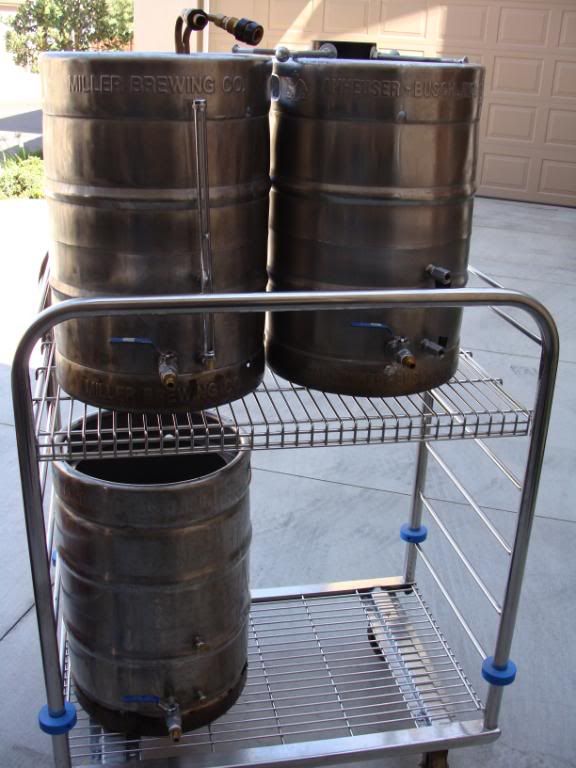JUSTINTIMEBREWING
Well-Known Member
I'm building a brew cart... I have one march pump, three keggles, and three burners. 1 tier or 2 tier cart?

hmm im almost leaning towards the single tier one pump batch sparging method...
hmm im almost leaning towards the single tier one pump batch sparging method...
Two tier, one pump. MLT on top, HLT and BK on bottom.
Fly sparge with pump feed and gravity drain.
This is what I'm leaning towards as well. My only concern is using a pump for draining my my mash to my BK. I'm worried too much suction might cause channeling. Is this just pish posh in my head?
If you have any back issues or other physical limitations then a single tier is a better way to go. My brew days are much easier now that I use 2 pumps on a single tier.
Sounds like a PITA.No such thing as channeling in batch sparging. However, you do have to be careful about compacting the grainbed with pumped recirculation or draining. One thing that helps is to start slowly to set the bed and slow the runoff speed as you get down to about a gallon left. If you rush this part, you end up losing your siphon/pump prime while wort is still trickling down through bed and under the false bottom. Sometimes I even stop pumping when there's about a gallon left so that I give it a chance to drip down and collect under the FB.
Where can I find a detailed explanation about RIMS and HERMS?
If I do single tier one pump whats the best way to mash? Batch sparging? and how would this process go? btw I will be direct fire mashing in a keggle. Sorry guys if these are dumb questions i'm new to all grain brewing.
I like this idea.My setup is a bit different. When I originally built it 15 years ago, everything was very, very, erm, very expensive, so I did a two-tier, but I have my HLT on the top tier and MT and BK on the second tier. I used gravity for HLT and pumped between the MT and BK, then gravity from the BK through the CFC and into my fermenter that sat on the floor. Now that I'm completely redesigning and overhauling my rig, I've opted to keep my setup the same, even though I'm now pumping from my HLT (HLT is electric now, and I recirc the liquor to maintain even temp). Even though the HLT is essentially over head, so what? The HLT is the one kettle that doesn't need to be scrubbed clean after every batch.
I do have a design in my head for a very compact configuration that is nearly at ground level to minmize heavy lifting, but that's more looking forward a few years as I get old and broken down
MrH
I like this idea.
I brewed using this setup for a very long time with one pump. Since you say you're new to AG brewing I think you need to decide what you want out of it. Keep in mind that RIMS, HERMS, and direct fire recirculating systems are nothing more than a means to accurately maintain mash temps. In all of these designs, you NEED the recirculation to even out the temp and clarify your wort. This means you need at least one pump dedicated to recirculation, at least while you're mashing. I used my pump to recirc during the mash, then to push the wort to the kettle during fly sparging. Since I have my HLT above my MT, I could gravity feed my sparge liquor to my MT. By comparing the flow between the two, it was actually pretty simple to match rates. I tried batch sparging once with my setup and had terrible efficiency (like 20 points less than normal). I don't doubt I could have improved that with practice, but with fly sparging I had a very consistent 84% brewhouse efficiency, so I stuck with what worked.
Actually, the only real difference in my setup now is that I've added an electric element to my HLT, and I've opted to use a recirc pump to maintain even temps in that. I will also use that same pump to feed my MT, but mainly because it makes the plumbing simpler.
MrH


Another factor to consider is your cooling method. If you are using a CFC, you would want your BK high enough to allow gravity flow to your fermenter. (maybe I'm just stating the obvious)

Not if you have a pump.
I have been using a 3 tier, but now that I have a pump, I can now have a much lower stand but still be able to fly sparge if I wanted to. I plan on lowering the post substantially, and rotating it so the MLT is closer and the HLT is further away, and I'll have the BK closer and lower to the ground as well. I hate having the HLT directly over the BK, it restricts access and sometimes the burner flakes off paint and rust into the BK. I'll also make a shelf for the portable RIMS kit below the MLT, and eventually a splitter for a single propane tank to feed both burners. This means no more stepladders. If the pump died I could still do at least a 5g batch using gravity, and more if I did some work with a bucket. I have to get the welder out to make a mount for a newer burner anyway, at the moment it's just sitting on a pile of pavers.
Before and after (excuse the lazy photoshop using just my trackpad)
Enter your email address to join: